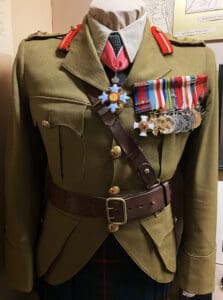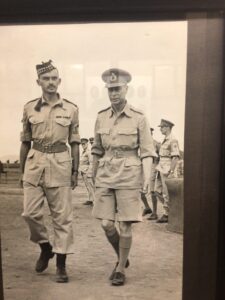Khaki tunic with Brigadier gorgets on lapels, medals mounted on chest with CBE around neck. Sam Browne, Davidson tartan kilt, glengarry and officer’s tie. All original worn by Brig. Johnston. Shirt from Museum collection.
Medals: a) Distinguished Service Order with Bar; b) 1939-1945 Star; c) The Italy Star d) The France & Germany Star; e) Defence medal; f) Canadian Volunteer Service medal with Clasp; g) The 1939-1945 War medal with Mentioned in Dispatches Insignia; h) 1953 Coronation Medal; i) 1967 Centennial Medal; j) 1977 Jubilee Medal; k) Canadian Efficiency Decoration; l) Canadian Forces Decoration; m) Knight of the Legion of Honour (France); n) The War Cross 1939-1945 with mentioned in dispatches insignia; o) The CBE (Commander of the Order of the British Empire) medal, worn around the neck.
Ian Strachan Johnston CBE DSO (2) ED KC was born on 12 August 1908 in Toronto, Ontario. He was educated at Ridley College in St. Catharines, Ontario, 1921 to 1925 earning the highest military rank of any Old Boy in the school’s history. He attended Royal Military College in Kingston, Ontario from 1925 to 1930 with the commission number 47593. Johnston joined the 48th Highlanders of Canada in 1930 as a 2nd Lieutenant and in 1933 was called to the Bar of Ontario and began practicing law. On September 1939, Johnston joined the 1st Battalion, 48th Highlanders of Canada for overseas duty, being appointed Adjutant and Captain on 5 September. He travelled with the advance party to Halifax on 16 December and sailed with the battalion on the Reina del Pacifico that month. In December 1940, he was was promoted to Major as Officer Commanding D Company, followed by an appointment to Commanding Officer of the 48th Highlanders in January 1943 and promotion on 5 May to Lieutenant-Colonel. Johnston led the battalion in the landings at Pachino, Sicily on 09 July 1943, then the Sicilian campaign and the advance up Italy including San Leonardo, the Gully, Ortona, San Nicola – San Tommaso, the Liri Valley and the Hitler Line. LCol Johnston was awarded the Distinguished Service Order at Ortona Crossroads which opened up the final advance to Ortona. On the night of December 23rd-24th, the 48th Highlanders, commanded by Lieutenant-Colonel Ian Strachan Johnston, performed one of the most remarkable feats of the war. Carrying only personal weapons, the Battalion moved off into the night in single file in the rain following a hidden footpath, penetrating unseen a mile behind the German lines, then dug in an all round defence by dawn. The Battalion spent Christmas Day surrounded by enemy firepower, with fire from German 88 MM guns, machine-guns, mortars, and snipers. That night a 48th officer, leading 180 Saskatoon Light Infantry, used the same foot path bringing food, ammunition, radio batteries, and rum. At 1000 hours on December 26th, the enemy threw everything it had at the 48th. The fighting was intense, and often hand-to-hand. Then the 48th’s Information Officer, who had left back along the foot path in daylight returned guiding three tanks of the Ontario Regiment. With the tanks in support, the 48th Highlanders now launched their own counter-attack, wreaking havoc on the Germans. An estimated 120 Germans were killed or captured. The 48th, in 3 days, had lost just eight killed and six wounded. Now the only road for the Germans into or out of Ortona was threatened. On the night of December 27th-28th, the German paratroopers abandoned Ortona. Then came the Hitler Line, fortified by concrete, artillery, mortars, machine guns, anti-tank ditches, wire, Teller and box mines, and manned by 8,300 troops. On 22 May 1944, and without tactical support, the 48th Highlanders became the first Canadian battalion to break the Germans’ strongest position in Italy. In recognition, Johnston was made Chevalier de la Legion d’Honneur (Order of the Legion of Honour, Knight) and awarded the Croix de Guerre avec Palme (War Cross 1939-1945 with bronze Palm). In June 1944, he was promoted to Brigadier in command of the 11th Canadian Infantry Brigade. In February 1945, he proceeded the North-West Europe campaign, where Johnston and his brigade led a major attack on German forces in Holland. In June 1945, he was promoted to General Officer Commanding, [A/MajGen] 5th Canadian Armoured Division . Brigadier Johnston remained in Europe to act as one of the judges in the Court Martial of Kurt Meyer for the killings at Abbey d’Ardennes.


